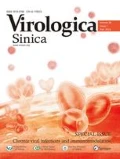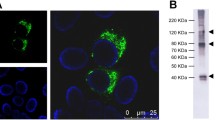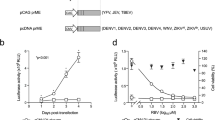Abstract
Zika virus (ZIKV) causes rash, moderate fever, conjunctivitis, and arthralgia, and has serious connection with neurological complications; therefore, it is a major threat to public health. A rapid and supersensitive method for detecting anti-ZIKV antibodies in humans and animals is thus urgently required. Here, we report an NS1-based luciferase immunosorbent assay (LISA), developed to detect ZIKV-specific IgG. Fusion proteins including a reporter Nano-luciferase (NLuc) and various fragments of ZIKV NS1 protein were expressed in 293 T cells. LISA was performed using the above cell lysates containing the expressed fusion proteins. Sample panels of humans and animals infected with ZIKV were examined for sensitivity of LISA, relative to those of ZIKV RT-PCR, commercial NS1-based ELISA, and micro-neutralization (MN) assays. Specificity and potential cross-reactivity were also evaluated using various convalescent serum samples derived from patients infected with dengue virus (DENV), Japanese encephalitis virus (JEV), and hepatitis C virus (HCV). Results indicated the optimal antigenic domain for anti-ZIKV IgG detection was located within 172–352 amino acids (aa) of ZIKV NS1 protein. NS1-based LISA performs better than commercial ELISA in anti-ZIKV IgG detection. LISA was shown to be at least fourfold more sensitive than commercial ELISA, and could detect anti-ZIKV IgG in various animal hosts without the need of species-specific labeled antibody. This novel assay is potentially useful for the rapid and sensitive detection of anti-ZIKV IgG in human and animal samples.






Similar content being viewed by others
References
Balmaseda A, Stettler K, Medialdea-Carrera R, Collado D, Jin X, Zambrana JV, Jaconi S, Cameroni E, Saborio S, Rovida F, Percivalle E, Ijaz S, Dicks S, Ushiro-Lumb I, Barzon L, Siqueira P, Brown DWG, Baldanti F, Tedder R, Zambon M, de Filippis AMB, Harris E, Corti D (2017) Antibody-based assay discriminates Zika virus infection from other flaviviruses. Proc Natl Acad Sci USA 114:8384–8389
Corbett KS, Katzelnick L, Tissera H, Amerasinghe A, de Silva AD, de Silva AM (2015) Preexisting neutralizing antibody responses distinguish clinically inapparent and apparent dengue virus infections in a Sri Lankan pediatric cohort. J Infect Dis 211:590–599
de Oliveira WK, Carmo EH, Henriques CM, Coelho G, Vazquez E, Cortez-Escalante J, Molina J, Aldighieri S, Espinal MA, Dye C (2017) Zika virus infection and associated neurologic disorders in Brazil. N Engl J Med 376:1591–1593
Dejnirattisai W, Supasa P, Wongwiwat W, Rouvinski A, Barba-Spaeth G, Duangchinda T, Sakuntabhai A, Cao-Lormeau V-M, Malasit P, Rey FA, Mongkolsapaya J, Screaton GR (2016) Dengue virus sero-cross-reactivity drives antibody-dependent enhancement of infection with zika virus. Nat Immunol 17:1102–1108
Di Guardo G (2018) Commentary: Zika virus in the Americas—yet another arbovirus threat. Front Microbiol 9:435
Franca GVA, Schuler-Faccini L, Oliveira WK, Henriques CMP, Carmo EH, Pedi VD, Nunes ML, Castro MC, Serruya S, Silveira MF, Barros FC, Victora CG (2016) Congenital Zika virus syndrome in Brazil: a case series of the first 1501 livebirths with complete investigation. Lancet 388:891–897
Gao X, Wen Y, Wang J, Hong W, Li C, Zhao L, Yin C, Jin X, Zhang F, Yu L (2018) Delayed and highly specific antibody response to nonstructural protein 1 (NS1) revealed during natural human ZIKV infection by NS1-based capture ELISA. BMC Infect Dis 18:275
Guedes DR, Paiva MH, Donato MM, Barbosa PP, Krokovsky L, Rocha SWDS, Saraiva KLA, Crespo MM, Rezende TM, Wallau GL, Barbosa RM, Oliveira CM, Melo-Santos MA, Pena L, Cordeiro MT, de Franca RFO, de Oliveira AL, Peixoto CA, Leal WS, Ayres CF (2017) Zika virus replication in the mosquito Culex quinquefasciatus in Brazil. Emerg Microbes Infect 6:e69
Johansson MA, Mier-y-Teran-Romero L, Reefhuis J, Gilboa SM, Hills SL (2016) Zika and the risk of microcephaly. N Engl J Med 375:1–4
Lee H-J, Cho Y, Kang HJ, Choi H, Han KR, Chong CK, Kim YB (2018) Identification of peptide based B-cell epitopes in Zika virus NS1. Biochem Biophys Res Commun 505:1010–1014
Ludolfs D, Reinholz M, Schmitz H (2009) Highly specific detection of antibodies to tick-borne encephalitis (TBE) virus in humans using a domain III antigen and a sensitive immune complex (IC) ELISA. J Clin Virol 45:125–128
Lustig Y, Zelena H, Venturi G, Van Esbroeck M, Rothe C, Perret C, Koren R, Katz-Likvornik S, Mendelson E, Schwartz E (2017) Sensitivity and kinetics of an NS1-Based Zika virus enzyme-linked immunosorbent assay in Zika virus-infected travelers from Israel, the Czech Republic, Italy, Belgium, Germany, and Chile. J Clin Microbiol 55:1894–1901
Moura da Silva AA, Ganz JSS, da Sousa PS, Doriqui MJR, Ribeiro MRC, Branco MDRFC, de Queiroz RCS, de Pacheco MJT, Vieira da Costa FR, de Silva FS, Simoes VMF, Pacheco MAB, Lamy-Filho F, Lamy ZC, Soares de Britto EAMTS, (2016) Early growth and neurologic outcomes of infants with probable congenital Zika virus syndrome. Emerg Infect Dis 22:1953–1956
Petersen LR, Jamieson DJ, Powers AM, Honein MA (2016) Zika virus. N Engl J Med 374:1552–1563
Rastogi M, Sharma N, Singh SK (2016) Flavivirus NS1: a multifaceted enigmatic viral protein. Virol J 13:131
Reusken C, Pas S, GeurtsvanKessel C, Mogling R, van Kampen J, Langerak T, Koopmans M, van der Eijk A, van Gorp E (2016) Longitudinal follow-up of Zika virus RNA in semen of a traveller returning from Barbados to the Netherlands with Zika virus disease, March 2016. Euro Surveill. https://doi.org/10.2807/1560-7917.ES.2016.21.23.30251
Steinhagen K, Probst C, Radzimski C, Schmidt-Chanasit J, Emmerich P, van Esbroeck M, Schinkel J, Grobusch MP, Goorhuis A, Warnecke JM, Lattwein E, Komorowski L, Deerberg A, Saschenbrecker S, Stocker W, Schlumberger W (2016) Serodiagnosis of Zika virus (ZIKV) infections by a novel NS1-based ELISA devoid of cross-reactivity with dengue virus antibodies: a multicohort study of assay performance, 2015 to 2016. Euro Surveill. https://doi.org/10.2807/1560-7917.ES.2016.21.50.30426.
Wang Q, Yang H, Liu X, Dai L, Ma T, Qi J, Wong G, Peng R, Liu S, Li J, Li S, Song J, Liu J, He J, Yuan H, Xiong Y, Liao Y, Li J, Yang J, Tong Z, Griffin BD, Bi Y, Liang M, Xu X, Qin C, Cheng G, Zhang X, Wang P, Qiu X, Kobinger G, Shi Y, Yan J, Gao GF (2016) Molecular determinants of human neutralizing antibodies isolated from patient infected with Zika virus. Sci Transl Med 8:369ra179
Wang H, Cai Q, Liang Y, Shui J, Tang S (2019) A simple and high-throughput luciferase immunosorbent assay for both qualitative and semi-quantitative detection of anti-HIV-1 antibodies. Virus Res 263:9–15
Wiratsudakul A, Suparit P, Modchang C (2018) Dynamics of Zika virus outbreaks: an overview of mathematical modeling approaches. PeerJ 6:e4526
Wong SJ, Furuya A, Zou J, Xie X, Dupuis AP 2nd, Kramer LD, Shi P-Y (2017) A multiplex microsphere immunoassay for Zika virus diagnosis. EBioMedicine 16:136–140
Xu K, Song Y, Dai L, Zhang Y, Lu X, Xie Y, Zhang H, Cheng T, Wang Q, Huang Q, Bi Y, Liu WJ, Liu W, Li X, Qin C, Shi Y, Yan J, Zhou D, Gao GF (2018) Recombinant chimpanzee adenovirus vaccine AdC7-M/E protects against Zika virus infection and testis damage. J Virol 92:e01722-17
Yu L, Wang R, Gao F, Li M, Liu J, Wang J, Hong W, Zhao L, Wen Y, Yin C, Wang H, Zhang Q, Li Y, Zhou P, Zhang R, Liu Y, Tang X, Guan Y, Qin C-F, Chen L, Shi X, Jin X, Cheng G, Zhang F, Zhang L (2017) Delineating antibody recognition against Zika virus during natural infection. JCI Insight 2:e93042
Zhong Y-B, Liu X-Q, Deng Y-C, Xu P-H, Zhong G-R, Zhang W (2016) First case of laboratory-confirmed Zika virus infection imported into China. Chin Med J (Engl) 129:2013–2014
Acknowledgements
This work was supported by the following grants: the National Key Research and Development Program of China (2016YFD0500301), the National Major Project for Control and Prevention of Infectious Disease in China (2018ZX10101002 and 2017YFC1200503), the Bureau of Science and Information Technology of Guangzhou Municipality, China (201604020011, 201704020219), and National Key R&D Program of China (2018ZX10732401). The funders had no role in study design, data collection and analysis, decision to publish, or preparation of the manuscript. We thank all the staffs from respective authorities of China for providing all samples.
Author information
Authors and Affiliations
Contributions
ST and WT conceived and designed experiments. TW, YZ, YD and W Wu performed the experiments. TW, W Wang and WT analyzed the data. DW, ZC, W Wu and W Wang contributed reagents/material/analysis tools. TW, ST and WT wrote the manuscript.
Corresponding authors
Ethics declarations
Conflict of interest
The authors declare that they have no conflict of interest.
Animal and Human Rights Statement
A total of 151 samples from human and animal were used in this study, which was approved by the Ethics Committee of Southern Medical University (SMU No. 20160428) and the National Institute for Viral Disease Control and Prevention of China (IVDC No. 2016072501), as well as the waiver of the Informed Consents.
Electronic supplementary material
Below is the link to the electronic supplementary material.
Rights and permissions
About this article
Cite this article
Wang, T., Zhan, Y., Wu, D. et al. Development and Evaluation of a Universal and Supersensitive NS1-Based Luciferase Immunosorbent Assay to Detect Zika Virus-Specific IgG. Virol. Sin. 35, 93–102 (2020). https://doi.org/10.1007/s12250-019-00160-x
Received:
Accepted:
Published:
Issue Date:
DOI: https://doi.org/10.1007/s12250-019-00160-x




